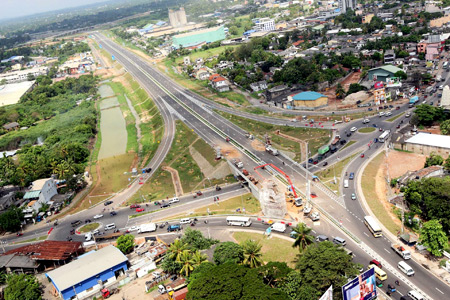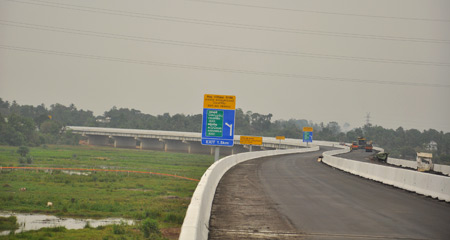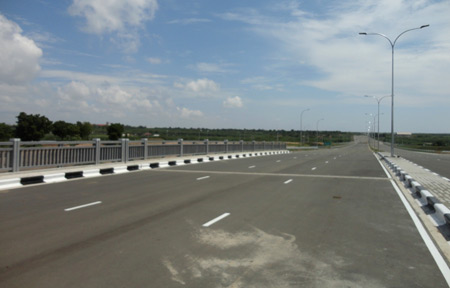National highways: The true story
By. R.W. Ranjith Pemasiri
Multilateral and bilateral convention donors offer around US$ 200 m
to US$300 m per annum for the highways sector in compliance with its
eligibility and procurement guidelines.
 However, the funding provisions are not sufficient to carry out a
large scale accelerated development program. However, the funding provisions are not sufficient to carry out a
large scale accelerated development program.
The predicament is whether we should open up other avenues to obtain
funding with appropriate regulatory measures to achieve the development
targets or we should confine to the limited funding from conventional
donors and thus achieve a slow growth in development in highways? The
obvious choice is to look for new funding arrangements to fast-track the
Highway Development process which has a positive impact on other
economic sectors for a faster national development and growth.
The recent articles in the newspapers have attempted to suggest that
the expressways constructed in the country are expensive compared to
those constructed elsewhere in the world and that the procurement of
contracts are through stand-alone proposals associated with lack of
competition and at a huge cost.
This response is meant to correct the misleading statements 'dished
out' to readers of newspapers without giving the true picture of the
highway and expressway development, with correct facts and figures.
The expressways constructed in Sri Lanka were well planned,
formulated, prioritised and implemented. Due to the prolonged 30 year
conflict the country fell back 50 years in all its development
spheres. The government development agenda was to carry out an
accelerated road development program to facilitate overall development
in other economic sectors.
The planning and execution of rehabilitation and development was not
restricted only to national roads and expressways but also the rural
roads. 7000 km of national roads have being rehabilitated already and
developed upto national standards. The present network of national roads
is 11800 km including some link roads taken over recently. The
development of the national network of roads is planned and documented
in the ten year road master plan, 2007-2017, titled National Road Master
Plan (NRMP).
NRMP provides the program based prioritised plan to develop the
network. This volume of the NRMP addresses the key issues in the highway
sector, and proposed remedial action and implementation framework for
the period 2008 to 2017. The proposed programs includes (a) program to
reduce traffic congestion, (b) road upgrading and rehabilitation
programs, (c) required legal and regulatory framework, (d) measures to
expedite land acquisition and thereby speed up project implementation
process (e) strategies and implementation plans for strengthening the
road agencies (f) program for new highway constructions to improve
connectivity of different regions, (g) remedial actions for road
construction material issues, (h) measures to strengthen the social and
environmental safeguards, (i) financial implications and (j) proposed
strategies for financing the ten year highway development program.
 In broad terms, the NRMP will be the tool for future policy and
strategy formulation and provide the framework for expeditious
implementation of highway sector projects. In broad terms, the NRMP will be the tool for future policy and
strategy formulation and provide the framework for expeditious
implementation of highway sector projects.
The implementation of NRMP would help the country to own the best
connected, high mobility road network that will cater to the ever
increasing needs. Besides the development of network of highways is
complementary to the ongoing accelerated economic development program,
which necessitates corollary activities from all sectors of the economy.
Hence the total program will generate synergistic effects in a positive
way helping the acceleration of economic growth, creation of productive
employment and reduction of structural poverty in a most cost effective
manner. Improved mobility helped by effective communication and
transparency will also prove the presence of good governance.
The Expressway network was executed through a planned schedule. The
Kottawa - Pinnaduwa (Galle) 4 lane Highway (95km) was constructed and
opened for traffic on November 27th 2011. The Katunayake Expressway
(26km) was constructed and opened on 27th October 2013. In the first
section of the Outer Circular Highway, 11 km out of 29 km was opened on
8th March 2014.
The second section 8.9 km long, is scheduled to be completed in June
2015. The extension of the Southern Expressway from Galle - Pinnaduwa -Godagama,
Matara was completed and put to use on 15th March 2014.
All these were not 'Stand alone' proposals. The Southern Expressway
from Kottawa - Pinnaduwa was procured as three contract packages on a
basis of competitive bidding. The Outer Circular Highway's 1st section
and the 2nd section were procured through competitive bidding. The
critics have attempted to mislead the newspaper readers as by implying
that all the expressways constructed were through stand-alone proposals.
 With the eradication of terrorism which had retarded the development
process for nearly three decades and the consequent establishment of
peace, the government initiated an accelerated infrastructure
development program to facilitate rapid economic and social development
to uplift the living standards of the citizens. With the eradication of terrorism which had retarded the development
process for nearly three decades and the consequent establishment of
peace, the government initiated an accelerated infrastructure
development program to facilitate rapid economic and social development
to uplift the living standards of the citizens.
The mobilisation of funds through conventional lending agencies
involves a long process and Sri Lanka with the attainment of the status
of a middle income country was no longer eligible for concessionary
loans.
Under this scenario, with the expansion of bilateral lending
arrangements through export credit agencies of emerging economies where
each lender has its own procurement system and where lending governments
or agencies nominate their contractors, implementing large-scale
infrastructure projects through 'Stand alone' proposals became a viable
alternative. In this context, world's largest emerging economy, the
people's Republic of China offered us credit with the eligibility and
procurement guidelines which we found to be a viable alternative, to
secure funds for large scale infrastructure projects. In our case the
Government of China accepted all our proposals and agreed to grant the
credit facilities complying with the China Exim Bank and the Sri Lanka
Government regulations for the projects in hand.
The government in 2011 introduced procurement guidelines to cater to
procurement of such 'Stand alone' proposals through a process which is
both expeditious and transparent, for the implementation of large scale
projects which would be exceptionally beneficial to the country and the
people with due review through high level committees.
It should be noted that all expressway projects awarded on the basis
of 'Stand alone' proposals have been procured through a process in
accordance with the above mentioned guidelines.
The comparison of cost between the expressways in Sri Lanka with
that of other countries is inappropriate for several reasons. When
conditions are not similar, comparisons are unrealistic.
However the engineers would like to select the traces that yield
minimum cost of construction, the possibility of environmental and
social impact may be high. In order to reduce the social impact due to
displacement of people, almost all the traces in which expressways were
constructed or being constructed, run through marshy lands.
Those traces run through areas of 'Soft' soils, such as peat which
need expensive treatment for stabilisation. Even otherwise construction
costs are higher than on the normal ground. In the case of CKE (Colombo
- Katunayake), the trace covers the entire Muthurajawela marshy lands.
The STDP, Southern Transport Development Project (STDP) and the Outer
Circular Highway (OCH) are also similar. The critical writers compare
the expressways in India and state that it varies between US$2 to 8
million per km. This is Rs. 260 million - Rs. 1050 million. In India
labour wages are cheap.
The unskilled labour is Ind. Rs. 100-150 per day, material such as
rock aggregate is cheap at Rs. 375-600 per m3 and also the soil. The
cost of unskilled labour in Sri Lanka is Rs. 1000-1500 per day, rock
aggregate Rs.1600-2500 per/m3, and the soil when brought to site is Rs.
1000-1500/m3. The prices of bitumen, cement and steel are equally high.
Therefore the cost of construction is inevitably high.
In India most of the roads cut across sparsely populated and flat
terrain, with less water crossings. The human settlement in India are
discreetly placed when compared with Sri Lanka.
It is also noted that in India the number of crossings going via
expressways are less than that of Sri Lanka. Though our country is small
we have densely spread waterways requiring numerous bridges and
culverts. For example the 26km CKE (Colombo - Katunayake Expressway) has
42 bridges and 106 box and pipe culverts and a 1300 m long viaduct.
The benefit of expressways in order to increase mobility need not be
over emphasized. The ribbon development along the national network of
road is extremely high. No matter how much these are improved, the
average speed cannot be increased appreciably. Presently it is around 38
km/hour or less, with the increase of traffic this too has become less
and in urban areas this is as low as 10-20 km/hr.
The completed expressways have yielded very high travel time savings.
Kottawa - Galle is in the range of 1 hr/trip, Kottawa - Matara is in the
range of 1 1/2 hrs/ trip. Colombo - Katunayake is around 30 min/trip.
The present traffic volume is much higher than it was predicted. Ex.
STDP 18,500 v.p.d against 9000 v.p.d, CKE 18,000 v.p.d against 12,000
v.p.d. The total revenue generated from the two Expressways up to date
is Rs 6250 million.
The initial feasibility study envisages recovering construction and
operation and maintenance costs within a 30-year period. The toll rates
are worked out on that basis. The present situation of higher number of
v.p.d, and the toll based on lower volume of traffic cannot yield loss
as stated in the newspaper articles. In fact its income is over and
above the predicted figures.
The usage of Southern Transport Development Project (STDP) by all
categories of vehicles, since the commencement of operation is shown
below (table 05)
The saving on travel time, fuel usage and vehicle operating cost is
very significant. The full benefit accrued due to travel time savings,
lower vehicle operating cost will not materialise overnight and takes a
long time. There are corollary effects in overall development due to
improved road infrastructure in almost all sectors such as industry,
tourism, fisheries, agriculture etc and strengthening good governance by
way of improved communication.
It is unfortunate that attempts have been made to devalue the very
positive, timely and appropriate development work which is carried out
on an accelerated phase which no one would have ever imagined 10 years
ago. Let us rally round and recognise the positive timely development
work aimed towards the upliftment of living standards of all citizens of
Sri Lanka without resorting to misleading theories and statistics.The
cost of construction of expressways and highways depend on the
topographical and geographical considerations of the road trace such as
good or poor sub soil conditions, volume of rock excavations etc. and
the number of bridges, culverts, flyovers and the under passes.
Other technical aspects such as the number of lanes and the number of
interchanges also have an effect on the total cost.
The cost will also depend on whether the facilities are constructed
in densely populated or sparsely populated areas and the efforts made to
minimize the adverse social and environmental impacts. However the
comparisons referred to in the illustrative article do not take such
variations into account.
To avoid displacement of people due to the construction of
expressways which is kept to a minimum, the road traces have been
shifted to marshy areas in several locations. Also, in order to mitigate
adverse environmental impact due to construction of expressways in
marshy areas, long viaducts are introduced in the design.
It should also be noted that Sri Lanka is blessed with a large number
of rivers and tributaries, the number of bridges and culverts necessary
to be constructed are high. All these contribute to the increase in cost
of expressways and highways in Sri Lanka.
Therefore a realistic comparison in the cost of construction of
projects within or outside the country should also take into account all
such factors making allowance for escalation of prices that may occur or
have occurred.
Based on the revenue generated from the Southern Expressway, the
first set of newspaper articles attempted point a picture that the
RDA has incurred a financial loss in 2013. If the logic of this argument
is extended to the non fee levying national highway network, then it
follows that the RDA is perennially incurring a whopping annual loss
calculated at the annual total cost of rehabilitation, maintenance and
debt service cost of the network.
No road project will give a financial return immediately. Most of the
projects are financially not viable, but are economically viable. It
will take longer time to justify the investment, risk and the trouble.
This is the case all over the world. The economic rate of return of
the investment on a highway network of the country is calculated on a
more complex analysis of cost and benefit, arising, inter alia, on
saving on time, savings in vehicle operating costs etc and indirect
benefits derived through contributions made to the economic development
of the country.
It should be noted that feasibility studies which evaluate the costs
and benefits are always carried out for all large scale projects such as
construction of expressways and the projects are selected for
implementation, only if such studies show that the potential economic
rates of return exceed minimum accepted threshold values.
The writer is the Secretary to the Ministry of Highways, Ports and
Shipping and the Acting Chairman of the Road Development Authority. |

